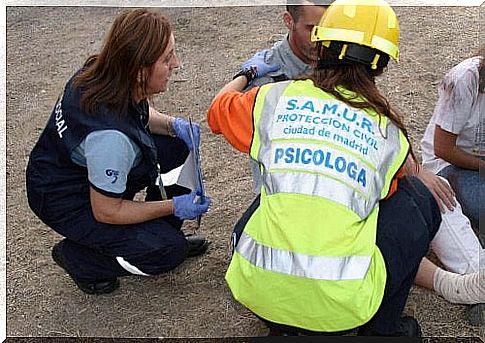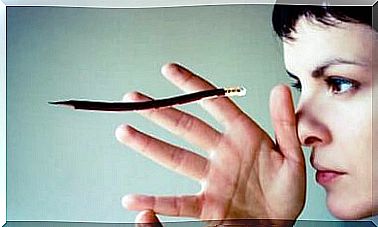Do You Know What Debriefing Is?

The psychological debriefing is a brief intervention that takes place in the first days following a traumatic event. This event can be a natural disaster (earthquake, flood, etc.), a traffic, air or rail accident, etc.
A group of colleagues or people who have experienced the event in a similar way is formed to carry out the debriefing. The objective is to promote intra-group support between those who have been involved in the same situation under similar conditions.
The goal is therefore to create a space where all feelings, thoughts and reactions related to what has been experienced can be expressed in a safe way. This will help prevent future mental disorders.
These people come together to break down the emotional charge that has built up through the experience. The debriefing is led by a psychologist. The meeting seeks to get people who were present during the traumatic event to verbally expose what they experienced.
Therefore, debriefing is a technique designed to close and integrate potentially traumatic events. This technique also introduces emotional and technical learning. This tool is considered to be a great help in preventing the exacerbation of symptoms in emergency professionals.

Professionals also suffer
Emergency professionals are also human. Indeed, they endure, suffer and sometimes also need help. We often forget them. These professionals are at high risk for psychological damage associated with their work. It is therefore particularly important to provide them with immediate assistance, sometimes for preventive purposes, in high-impact situations.
They are often assigned tasks regardless of their age, education, skills or experience. This can cause symptoms of increasing stress to appear. Sometimes it is the professional himself who is unable to recognize that the situation is beyond him.
In the event of a disaster, the intervention does not adapt to a fixed or predictable schedule. In the organization of teams, the requirements expected from the professional are diverse and urgent.
The resources that must be implemented (if they have them) are numerous. Responses which are not very operational but which, in view of the size and characteristics of the situation to be treated are necessary, may appear.
Symptoms experienced by an emergency room professional
The symptoms that an emergency professional can experience after a disaster are varied. Physiologically, the technician who develops his function under pressure may suffer from fatigue, nausea, chills, lack of air, etc.
Cognitively, he will certainly be very alert and vigilant. In addition, he will have negative thoughts that he will not know how to stop. His emotional response will be fear, anxiety, irritation and even emotional “shock”.
At the engine level, he will be unable to rest. He will also have an accelerated speech and shout in the conversation. A debriefing is used to prevent these symptoms from getting worse. The latter is undoubtedly an exceptional tool.
Why is it important to recognize our own stress and act on it?
The effects of stress on emergency workers can be really damaging. Let’s see some of these effects:
– At the workplace:
- Deterioration in the quality of their work
- Increase in absenteeism at work
- Less involvement
- Increased conflicts with colleagues, superiors or subordinates
– In the family environment:
- Having conflicts with spouse or other relatives
- Talk about negative emotions and stories the parent is not prepared for
- Isolate yourself, close yourself off so as not to involve the family member

Starting the debriefing
Helping emergency professionals does not stop with intervention. She doi t be extended once the team realized change. These are actions that should be explicit in the organization of work. A kind of maintenance work to prevent wear and tear on the most important parts of the gear: people.
On the other hand, group support or emotional support meetings have both supporters and detractors. Many organizations use this technique, in some of its versions, to help manage the emotions of those helping during a disaster.
These meetings have a set of rules and are led by an expert. During the latter, the participants relate in a differentiated way the objective events and the cognitive and emotional reactions that they have experienced.
A relaxed working group meeting should be encouraged once the shift change is complete or when the rescue is complete. Participants will be encouraged to :
- Tell the story
- Talk about feelings
- Inform them of symptoms they may be experiencing or may experience in the next few days
- Give them directions on how to act on these symptoms

Debriefing phases
The debriefing process cannot be improvised. Indeed, it is structured according to the following phases:
- Explanation of objectives
- Facts : each member identifies himself and explains what happened
- Thoughts : each member describes what they saw and heard and the thoughts they had
- Reaction : the reactions are commented. Each member is invited to focus on the worst they have been through
- Symptoms : each member comments on the stress reactions felt immediately after the incident and the current reactions
- Teaching : the debriefing emphasizes the normality of these reactions. Adaptation mechanisms are taught or reminded there.
- Reentry : the doubts are clarified. It is possible to say anything that has not been said before. Additional support is offered
Emergency workers may continue to show certain symptoms after the debriefing, after returning to “normalcy”. These symptoms include rejection of rest, self-criticism of how to act, feelings of being misunderstood by relatives or acquaintances, etc.
As we have seen, the stress that can arise after responding to an emergency or disaster can reach very high levels and be difficult to manage. Therefore, the debriefing takes place between the first 24 and 72 hours after the critical incident.
Debriefing seeks to put words into the suffering , to structure the event and to alleviate the stress produced by the experience. This is done in a structured way, under the guidance of an expert.
It is about learning to understand and manage the normal reactions derived from a difficult traumatic event. This takes place in a space where people finally feel in séc urité accompanied and guided therapeutically in the integration and resolution process.
Bibliographical references
Costa Marcé, A. and Gracia Blanco, M. de. (2002). Debriefing and psychological typhoon in intervention, in crisis: a review . Debriefing and Psychological Triage in crisis intervention: a review , 23 (5), 198-208.
Echeburúa, E. and Corral Gargallo, P. de. (2007). Crisis intervention among victims of traumatic events: when, how and for what? Crisis intervention in victims of traumatic events: when, how and what for? , 15 (3), 373-387.










